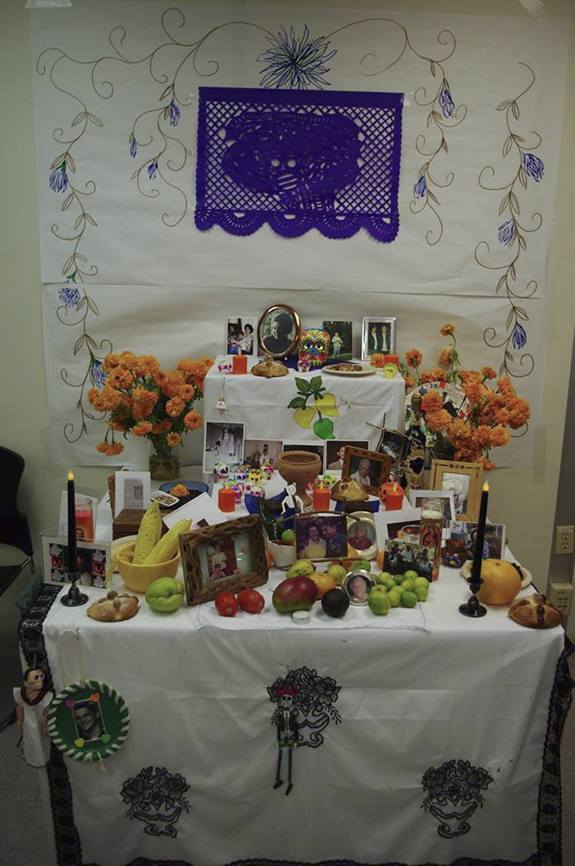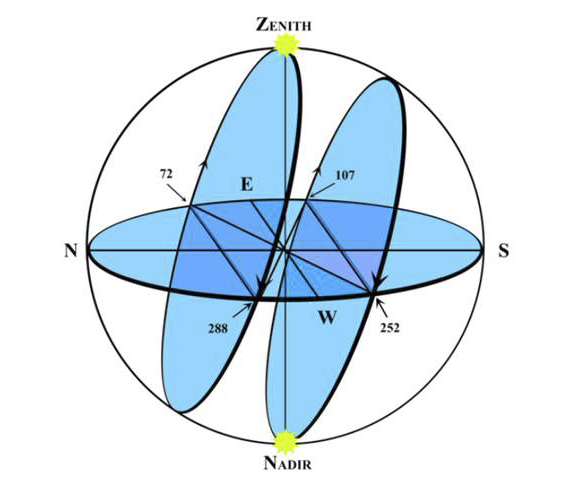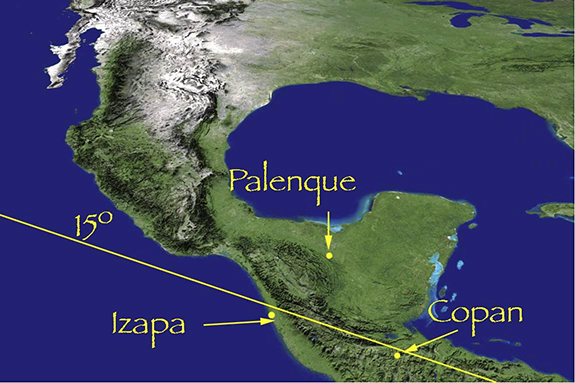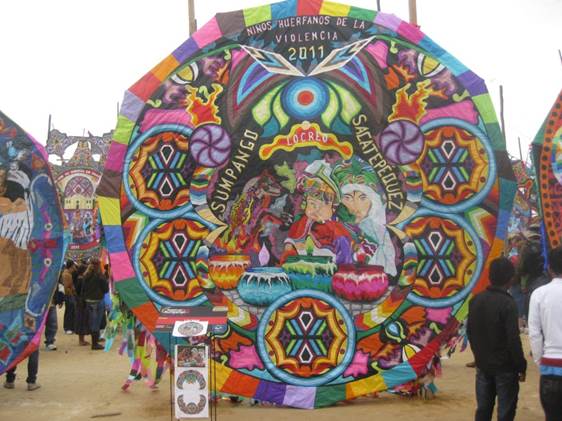Astronomia de los Muertos
October 31st - November 2nd is a festive time in the Americas, where we celebrate life by acknowledging the dead. The holidays of Halloween and Dia de los Muertos (Day of the Dead) have long and complex histories. However, as with many holidays, the roots of these celebrations have connections to astronomy.
Latin American Practices
The traditional holidays of Latin America at this time are:
November 1 - Día de los Inocentes (Day of the Innocents/Children)
November 2 - Día de los Muertos (Day of the Dead)
This is a lively time to remember and honor our ancestors and family members who came before us. It is not meant to be a melancholy or scary time. The traditions hold that during this time the souls of the dead return to visit their families. Images of skeletons dancing, doing comical things, and decorated with bright colors, clothing and flowers are common as a reminder of the joy in remembering our departed loved ones.

Dia de los Muertos Altar. Photo by B. Mendez
One of the traditions associated with this holiday is the creation of altars (ofrenda in Spanish) in people's homes to attract their loved ones. The altars are decorated with flowers (usually marigolds), candles, punched paper, water, sugar skulls, and pictures, favorite foods, and special possessions of the departed. The altars usually have three tiers or levels. The traditions of these altars are ancient and primarily indigenous. For example, many Maya people construct altars like those for Dia de los Muertos for many of their other important celebrations. For the Maya, the three levels represent the levels of creation in their cosmology: the underworld, the earth, and the sky. The items on the altars also are representations of the four elements: earth (food, flowers), air (punched paper), fire (candles), and water. The altar serves as a reminder of the cosmological context in which our observances exist.
On Dia le los Muertos, Latin American Families typically visit and decorate the graves of their loved ones, bringing food and playing music. They often use decorations similar to those in the altars.
Christian Practices
For many Christian denominations (especially Catholics), the holidays during this time are:
October 31: All Hallows’ Eve
November 1: All Saints’ (Hallows’) Day
November 2: All Souls' Day
These are solemn celebrations of those who have died. All Saint's Day is a feast day with specials mass celebrations to honor the saints (known and unknown). All Souls' Day commemorates all the souls who have died. These are days of prayer for the departed. These holidays began in the first millennium A.D. in Europe.
In Europe today, these holidays are often marked by visiting and decorating the graves of loved ones with flowers and candles. Bells are rung, and candles lit to comfort the dead in purgatory. Other traditions involve the baking of "soul cakes," which are then shared with the poor.
Halloween
The ancient Hebrew tradition of counting sunset as the end of the day and the start of the next influenced many Christian holidays to begin celebrations with a vigil at sunset of the previous day. All Saint's Day, is also known as All Hallow's Day. The vigil for the day therefore starts at sunset on October 31 and is known as All Hallow's Eve, or in contracted form, Halloween.
Halloween became popularized in the United States in the 20th century. Several of the modern American Halloween practices, like dressing up in costumes and going door to door to collect treats, are associated with Celtic festivities, particularly the harvest festival of Samhain (pronounced SAH-win).
Other themes and traditions in Halloween have roots in other European traditions (Roman, Pagan, etc.). Many cultures had celebrations with the themes of the dead visiting the living during this time.
In modern America, the holiday has taken on a more macabre element. The themes of the return of the dead have been considered with fear and dread. Dressing up as monsters and scaring ourselves with horror movies can be a way to diffuse that fear.
Cross-Quarter Day
So, where does the astronomy come in (apart from Halloween beginning at sunset)?

The dates of the quarter and cross-quarter days shown with Earth's location in its orbit around the Sun.
The harvest festival of Samhain, and many other pre-Christian festivals, were set to coincide with a cross-quarter day. The two equinoxes (22/23 of September and 20/21 of March) and two solstices (21/22 of December and June) are known in astronomical tradition as quarter days. They mark the extremes of the motion of the Sun in the sky. The half-way points between the equinoxes and solstices are called cross-quarter days. Celtic tradition held that the cross-quarter day on November 1st marked the first day of winter. The December solstice was consider mid-winter's day.
A common strategy to convert people to Christianity in first millennium Europe (and in 16th century Mesoamerica) was to adapt existing celebrations into Christian themes. All Saint's Day and All Souls' Day originally were celebrated on different days across different regions of Europe. The modern date of November 2 for All Souls' Day was set by a French monk in the eleventh century AD. During that century, the cross-quarter day fell on November 1st in the Julian Calendar. So, the move to that date is strongly suggestive of the attempt to co-opt the existing harvest celebrations.
Due to the rate of solar-alignment slip in the Julian Calendar (1 day every 128 years), this cross-quarter day was occurring on October 28th in 1581. When the Gregorian Calendar was enacted in 1582, the date of the cross-quarter day moved to November 6, where it remains today (the Gregorian Calendar has a much slower slip-rate). The dates of the All Saint's and All Souls' days did not move, and so preserved some cultural memory of their astronomical origins.
Astronomia del los Muertos
When the Catholic church began spreading Christianity in Mesoamerica during the 16th century, they found that many Indigenous peoples had similar celebrations of the dead like those in pre-Christian Europe. The traditions of the modern day Dia de los Muertos were celebrated in the summer time during first contact with Europe, culminating in a special ceremony honoring the dead on the September equinox. The Catholic church melded All Saints' and All Souls' Day themes with the Indigenous traditions about the dead and thus the modern version of Dia de los Muertos began to emerge.
The moving of Dia de los Muertos to November 2nd created a new astronomical connection of great importance for the Maya of Central America. On November 2nd, in the ancient Maya cities of Izapa and Copan (at 15-degrees north latitude), the Sun passes through the Nadir, the point directly beneath your feet, below the earth. Nadir passage is the complement to solar Zenith passage (when the Sun passes directly overhead). If solar Zenith passage represents the Sun delivering cosmic influence to the earthly realm, then solar Nadir passage represents the Sun delivering that influence to the underworld, Xi'bal'ba', and to the souls of the dead.

The paths of the Sun across the celestial sphere on Zenith passage and Nadir passage
Solar Nadir passage occurs throughout the Mayalands over the course of many months. The special significance of 15-degrees north latitude is both archeological and astronomical. The cities there may have originated several aspects of Maya calendrical traditions. Each year at 15-degree north latitude, the Sun passes through zenith on August 11th. Then, 132 days later, it reaches the lowest arc in the sky during the December solstice. 130 days after that, on April 30, the Sun once again passes through Zenith. This cycle between Zenith passages is then 262 days. Almost the same as the 260 day sacred Tzolk'in calendar of the Maya. The Sun moves northward for 52 days to the solstice on June 21st, and then back again toward the August 11th Zenith passage 51 days later. This lovely symmetry of 262 days (the gestational period of a human) and 103 days (the growing cycle of corn) between Zenith passages is also echoed in the solar Nadir passages.

The ancient Maya cities of Copan and Izapa are just south of 15 degrees north latitude.
Solar Nadir passage was celebrated by ancient Maya people as evidenced by architectural alignments in buildings like the Temple of the Cross and the Temple of Inscriptions at Palenque.
Modern Maya people still celebrate solar Nadir passage, and many do so during Dia del los Muertos. One example of this is the competition of giant kites at the cemetery in Sacatepequez, Guatemala. These kites are seen as a way to allow communication between the living and the dead.

Giant kites are flown in Guatemala in celebration of Dia del los Muertos
Halloween and Dia de los Muertos celebrate life in the midst of death. A millennia of history brought them together at this time here in the Americas. The movement of the Sun marks their beginning at sunset on October 31, (almost) halfway between the equinox and solstice. And the Sun's movement through the Nadir as seen from Izapa and Copan at midnight on November 2nd marks the end of this celebration.
1840